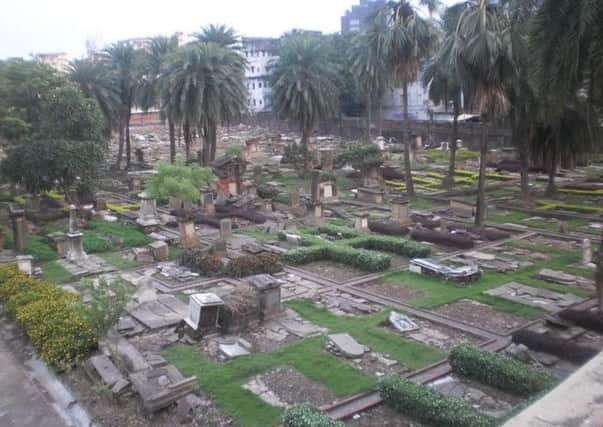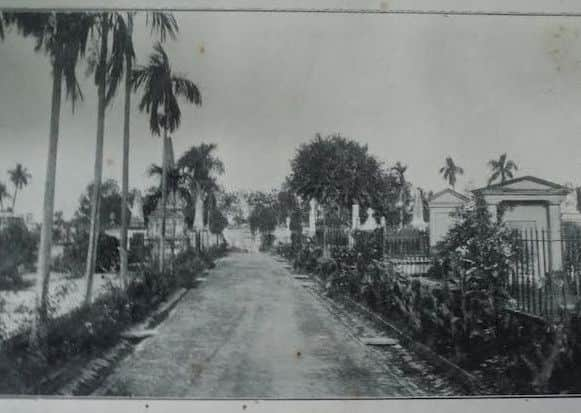The Calcutta cemetery where more than 3,000 Scots lie


Opened in 1820, the Scottish Cemetery of Calcutta was once a mighty Victorian monument, built of sandstone and granite graves, to those who had left Scotland to seek opportunities under the British Raj.
From the jute mill workers of Dundee to the industrialists, policemen, teachers and officers of East India Company - almost half of its writers were Scots - Calcutta became a very Scottish city in parts.


Advertisement
Hide AdAdvertisement
Hide AdTen years ago, the cemetery told a story of this past forgotten. Beyond the iron gates of the elaborate entrance, a 30ft jungle concealed almost all of the graves. Some of the city’s destitute had made their home among the tombs with snakes said to inhabit the most overgrown parts of the three-acre site.
In 2016, however, progress has been made to turn the cemetery from a place of the dead to a much-needed open space for the living, where the past is also remembered.
Lord Charles Bruce is chairman of the Kolkata Scottish Heritage Trust. Both his great-grandfather, Victor Bruce, 9th Earl of Elgin, and great- great-grand grandfather, James Bruce, 8th Earl of Elgin, served as Viceroy to India during the latter half of the 19th Century.
Lord Bruce said he “felt a duty as a Scot” to be involved in the restoration of the cemetery, where some Anglicans and Bengalis are also buried, which rapidly deteriorated during the 1970s when armed groups holed up within its perimeter walls.


He said: “The cemetery became completely hidden and to some extent it saved it from being developed but of course the memorials became terribly damaged by the roots of the trees.
“For the past five years we have been painstakingly carrying out ground engineering works and excavating parts of the cemetery. We are starting to restore some of the tombs.
“What we want to do is restore the cemetery as a green living space and to give the cemetery a purpose into the future.
Advertisement
Hide AdAdvertisement
Hide Ad“If you restore something that represents a large part of history, you have to make it relevant to people.
“We speak of the Scottish diaspora in America and Australia with pride but not much of the Scots diaspora in India. Yet we have this huge historic site connected to our history.”
The trust now spends around 2m Rupees - or just under £240,000 a year - on the project-and employs 30 people, including architect Neeta Das who works using surveys undertaken by the Royal Commission on the Ancient and Historical Monuments in Scotland in 2008.
Social projects have been set up to bring the surrounding community into the cemetery. A crucial step for the trust is to train local people as gardeners, stonemasons and guides with hopes it can attract visitors from around the world - and particularly Scotland - to the site.
Lord Bruce said: “We have got 4,000 names on our register of those buried here and more names keep appearing. There is a very strong connection between the cemetery and Dundee given the numbers of people who went to Calcutta to work on the jute mills on the Hoogly river.
“The people who came to Calcutta, well their life spans were often short. The cemetery is full of people from Dundee.”
Research carried out by the Friends of Dundee City Archives has unearthed information about those buried in the cemetery, which is part of the nearby St Andrew’s Kirk.
Advertisement
Hide AdAdvertisement
Hide AdThey include Charles Sabiston, a factory mechanic of Victoria Road, Dundee who died in Calcutta age 33 from delirium tremens on March 3 1900.
Another James Cameron , of Cleghorn Street, Dundee, a jute mill overseer with Samnaggur Jute Co Ltd, died on November 1897 aged 38 from a hepatic abscess.
One stone also lies in memory of a Mr James Wheatley, police constable who was murdered in the execution of his duty on the 26th of March, 1844, aged 28 years, 1 month & 10 days.
KSHT is focussing on the conservation of the most important historical structures, including the recumbent marble tomb where The Rev. Lal Behari Dey (1824 – 1892), a Bengali who converted to Christianity and became a missionary for the Free Church of Scotland.
As a boy, he was one of the first children to be enrolled in the school of the Kirk’s first overseas missionary, Rev Alexander Duff, which later became Scottish Church College, one of India’s most distinguished universities.
For Lord Bruce and the trust, much work still needs to be done. Several tonnes of debris has already been removed from the site by hand with the teams to finish clearance of the final quarter of the cemetery next year.
However, a finishing date for the project has not been set.
“i believe the cemetery will continue having an impact on people’s lives. In that sense, it is a project will never end,” he said.
